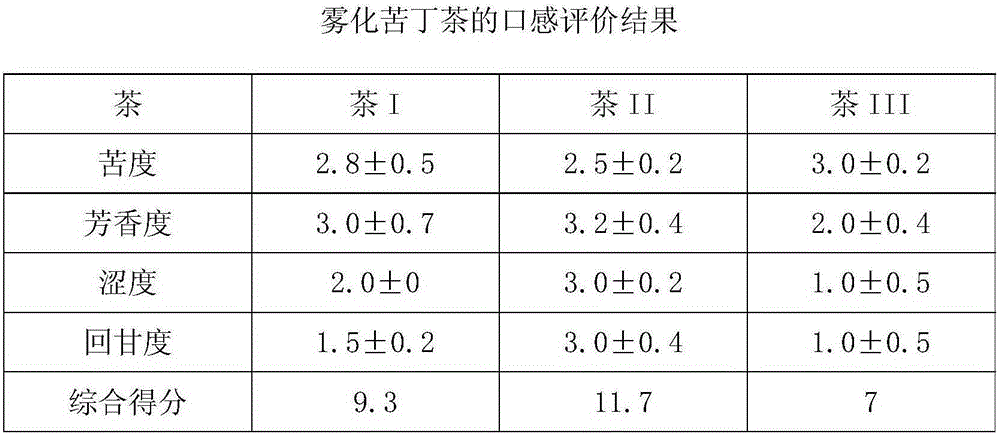Atomized broadleaf holly leaf and use thereof
A technology of Kudingcha and spray, which is applied in the field of atomized Kudingcha and its uses, can solve problems such as poor taste, unclear relationship between efficacy, and complicated sources of Kudingcha raw materials, so as to improve the taste and overcome the poor taste , to enhance the effect of efficacy
- Summary
- Abstract
- Description
- Claims
- Application Information
AI Technical Summary
Problems solved by technology
Method used
Image
Examples
Embodiment 1
[0029] Implementation Example 1 Preparation of Atomized Kudingcha Raw Material
[0030] At present, the production of Kudingcha is mainly the method of soaking in water. There are directly soaking in water for drinking, steaming (drying) after soaking in water to make powder and taking it with water after pulverizing the tea leaves. In order to improve the mouthfeel and improve efficacy, the present invention uses different concentrations of organic solvents for extraction. Since the most commonly used edible organic solvent is alcohol, here we take alcohol extraction as an example. On this basis, through decolorization treatment, the appearance is improved and the efficacy is further improved.
[0031] Materials and Methods
[0032] Kudingcha raw materials: commercially available Kudingcha holly (Huilong, Anhui), big-leaf holly Kudingcha (Anhui).
[0033] Chemical reagents: ethanol (chemically pure), n-butanol (chemically pure), macroporous resin
[0034] Preparation of al...
Embodiment 2
[0038] Implementation example 2 The chemical composition analysis of Kudingcha raw material
[0039] Materials and Methods
[0040] Kudingcha raw materials: including undecolorized and decolorized raw materials, provided by Nanjing Musai Biotechnology Co., Ltd., and the plant raw material is big-leaf holly. Its production process is the same as the concentration of implementation example 1. two kinds of Kudingcha raw materials are 100 mg / ml.
[0041] Analytical method: refer to the classic determination method recorded in Pharmacopoeia. Quantification of triterpene saponins: taking picricroside F as a standard, dilute the sample to be tested (3mg / mL) 100 times, and then measure the content. Quantification of total flavonoids: with rutin as a standard, the sample to be tested was diluted 50 times, and then the content was determined. Quantification of polyphenols: Determination of Foo-Lin phenol method. Quantification of soluble polysaccharides: determination by indirect me...
Embodiment 3
[0044] Implementation example 3 The mouthfeel improvement of atomized Kudingcha
[0045] Kudingcha prepared by conventional water soaking method contains a large amount of tannins, miscellaneous proteins, pigments, etc., has a bitter taste and short duration of aroma, and precipitation and color changes will occur when the aqueous solution is left for too long. In order to overcome this problem, we used the method of ethanol immersion to extract and measure the taste. The alcohol-extracted extract is dissolved and filtered with distilled water, and it is prepared into alcohol-extracted Kudingcha (tea I) with a concentration of 5 mg / mL, and Tween-80 and sodium chloride auxiliary materials are added to make a spray. Prepare the same concentration (5mg / mL) of decolorized alcohol-extracted Kudingcha (Tea II) in the same way to make a spray. As a control, we prepared water-extracted Kudingcha. Take 100 grams of Dayedongqing Kuding tea leaves, soak them in 1000 milliliters of 90-1...
PUM
 Login to View More
Login to View More Abstract
Description
Claims
Application Information
 Login to View More
Login to View More - R&D
- Intellectual Property
- Life Sciences
- Materials
- Tech Scout
- Unparalleled Data Quality
- Higher Quality Content
- 60% Fewer Hallucinations
Browse by: Latest US Patents, China's latest patents, Technical Efficacy Thesaurus, Application Domain, Technology Topic, Popular Technical Reports.
© 2025 PatSnap. All rights reserved.Legal|Privacy policy|Modern Slavery Act Transparency Statement|Sitemap|About US| Contact US: help@patsnap.com



